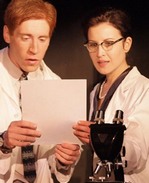HOME PAGE
SITE GUIDE
SEARCH
ADVERTISING AT CURTAINUP
REVIEWS
FEATURES
NEWS
Etcetera and
Short Term Listings
LISTINGS
Broadway
Off-Broadway
NYC Restaurants
BOOKS and CDs
OTHER PLACES
Berkshires
London
California
New Jersey
Philadelphia
Elsewhere
QUOTES
TKTS
PLAYWRIGHTS' ALBUMS
LETTERS TO EDITOR
FILM
LINKS
MISCELLANEOUS
Free Updates
Masthead
Writing for Us
A CurtainUp Los Angeles Review
Photograph 51
|
You think if you were to give an inch, we would take a mile, is that it? —— Wilkins It's true, isn't it? —— Rosalind — |

Graham Norris & Aria Alpert in Photograph 51
(Photo: Ed Krieger) |
This stunning production of Anna Ziegler's prize-winning play is whipped into a tightly-paced 90 minutes by director Simon Levy at The Fountain Theatre. Set designer Travis Gale Lewis and lighting designer Kathi O'Donohue shroud the stage in dimness, like the mystery surrounding the elusive double Helix. Spotlights pinpoint the characters, beginning with Aria Alpert, luminous as a prickly, independent Rosalind; Daniel Billet as her socially clumsy colleague Wilkins; Ian Gould, a vivid character as the greedy boy genius Watson; Kerby Joe Grubb as his colleague Crick; Ross Helwig as the dashing American scientist Casper, as close to a love interest as Rosalind gets; and Graham Norris as the doctoral student Gosling, whose unobtrusive flair for comedy should be exploited in some other production.
The competitive world of scientific discovery was largely closed to women in the 1950s when they were not even permitted to have lunch in the University's senior common room. Wilkins, who is portrayed as falling for Rosalind, eventually wants to work with her but it's too late. Ziegler depicts Rosalind as her own worst enemy. Whether rightly suspicious or a loner, she rejects all efforts to collaborate and works slowly, not realizing the race she is in. She apparently never knew that Wilkins, innocently or with obtuse resentment for her rejection of him personally and professionally, showed her Photograph 51 to Watson and Crick, who immediately grasped its significance and worked night and day to finalize the discovery and claim it as their own.
Although the play's scientific jargon may be too dense for the average viewer, it's delivered sparsely and in careful doses as the characters frantically scribble formulas on blackboards. Rosalind makes poetic references to her childhood and inherent character, describing how she arranges leaves not for themselves but to trace their veins. Her love for Caspar may or may not have been real, as the playwright always prefaces her romantic speeches to him as things Rosalind might have said. Also mysteriously vague is her deliberate carelessness around an X-ray machine. When Gosling screams he wouldn't endanger himself by standing in its rays, he says that to himself, not to her. The conjecture lingers that this may be a cause of the cancerous ovarian tumors that killed Rosalind at age 37.
Played by Alpert in the lab scenes with chilly dignity, Rosalind gets her moments of release from Ziegler in scenes where she climbs mountains and screams bad words into the wind or dreams of a love with Caspar in words she never speaks to him. Ziegler superbly sculpts the humanity and emotional lives of these scientists into their race for the prize.
The play was the winner of the 2008 Stage International Script Competition for Best New Play About Science and Technology. It well deserves the honor and this production does it justice.
|
Photograph 51 Playwright: Anna Ziegler Director: Simon Levy Producer: Bennett Bradley Cast: Aria Alpert (Rosalind), Daniel Billet (Wilkins), Ian Gould (Watson), Kerby Joe Grubb (Crick), Ross Hellwig (Casper), Graham Norris (Gosling) Set Design: Travis Gale Lewis Costume Design: Shon LeBlanc Lighting Design: Kathi O'Donohue Hair/Make-Up: Judi Lewin Sound Design: Peter Stenshoel Dialect Coach: JB Blanc Production Stage Manager: Elna Kordijan Running Time: 90 minutes, no intermission Running Dates: March 21-May 3, 2009 Where: The Fountain Theatre, 5060 Fountain Ave, Los Angeles. Reservations: (323) 663-1525 Reviewed by Laura Hitchcock on March 21, 2009. |
|







